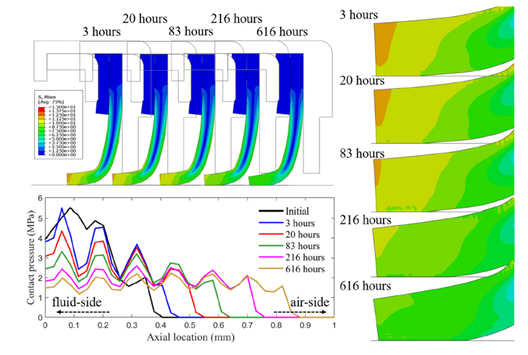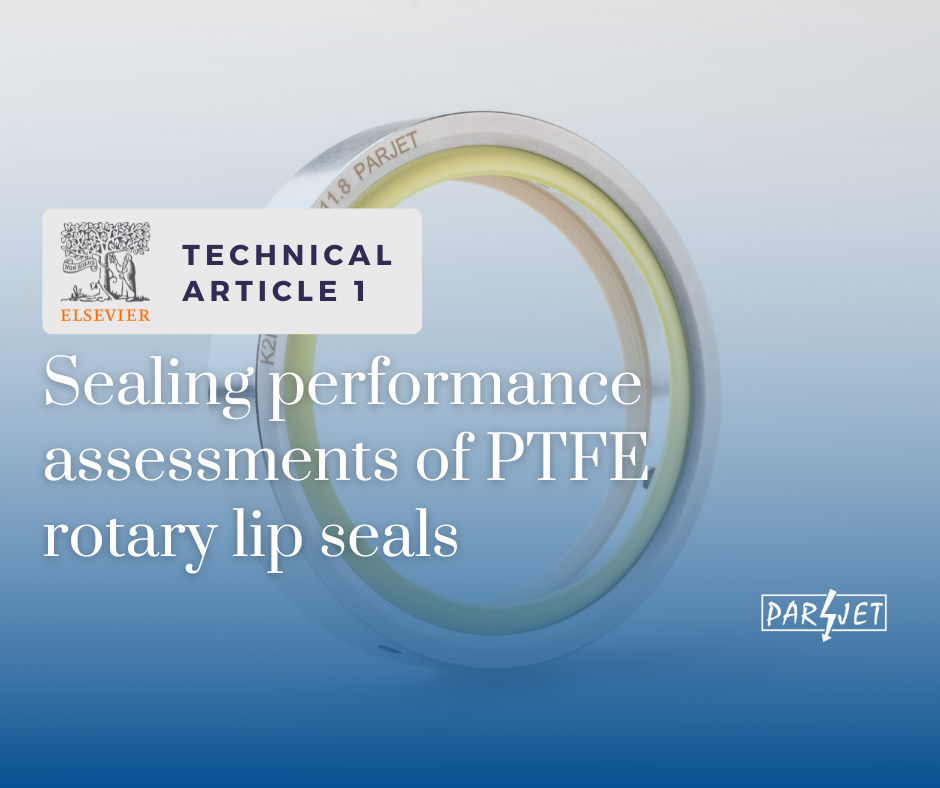With our collaboration with National Taiwan University, we are happy to share with our research article on the sealing performance of PTFE metal cased rotary lip seals based on the elasto-hydrodynamic analysis with the modified archard wear model.
Abstract
Numerical assessments based on the elasto-hydrodynamic analysis (EHA) in conjunction with the modified Archard wear model are conducted to efficiently appraise the potential leakage of polytetrafluoroethylene (PTFE) rotary lip seals after high cycle operations. The modified Archard model with the introduction of exponential relationships between the wear coefficient and film thickness obtained via the EHA is implemented into the commercial finite element software to estimate the wear amount on the seal. The EHA is then periodically activated to evaluate the variation of wear coefficient and reverse pumping rate for the updated geometry of the seal lip. Simulation results reveal that the design initially having large positive reverse pumping rate does not necessarily bear longer service durations before the leakage.
Introduction
Rotary lip seals made of Polytetrafluoroethylene (PTFE) are broadly used for the sealing of industrial components such as a crank shaft under high temperature, high pressure, or other harsh environmental conditions that elastomeric rotary lip seals cannot withstand. Contact width and pressure between the seal and rotating shaft might change due to wear and result in leakage after high cycle operations. An objective evaluation for the wear amount on the seal lip is therefore demanded in the early design stage. Thin film of sealed lubricant formed between the rotating shaft and seal lip is commonly observed under steady state conditions. Jagger [1] stated that the lubricating film, which carries loads and separates the seal lip from shaft, is capable of reducing wear and preventing the lip from mechanical and thermal damage. Jagger and Walker [2] further reported that the formation and maintenance of the film is strongly related to the microgeometry on the lip surface. Salant and Flaherty [3], [4] numerically evaluated distributions of the thickness and hydrodynamic pressure of the film between the rotary lip seal and shaft based on the elastohydrodynamic analysis with the numerical algorithm presented by Elrod [5] to describe the presence of cavitation regions. Sealing performances including the reverse pumping rate and friction torque were then evaluated based on both the fluid mechanics of the lubricating film and the elastic behavior of the lip. Shen [6] utilized a transient mixed lubrication model which considers the roughness of both the lip and shaft surface to simulate the average film thickness during the startup and shutdown period. This model was further utilized to explain effects of shaft roughness on seal characteristics such as the contact area ratio, cavitation area ratio, and reverse pumping rate in the study of Shen and Salant [7]. Liu et al. [8] proposed a multiscale thermal hydrodynamic lubrication model to assess the sealing performances of the rubber radial lip seal with the consideration of temperature-dependent aging behaviors. Based on the statements presented by Zhang [9], the reverse pumping effect was also regarded as an important indicator of sealing performance of PTFE seals. During operations, the sealed fluid would be successively pumped back to the oil-side with the properly distributed fluid pressure, and this performance is essentially influenced by the pattern of micro-asperity geometry. Bauer and Haas [10] explained the sealing mechanism of the PTFE lip seals with spiral grooves via observations of flow through the seal. Reichert and Schäfer [11] stated that the shaft facing side of the PTFE disc with a helical spiral combining with the rotary motion of the shaft allows the oil to flow along the helical groove towards the oil side. Generally, plain PTFE lip seals tend to increase leak rates at high speeds. Various factors including a change of the fluid film height in the sealing gap and reduced fluid viscosity or changes in the fluid flow could cause this effect. However, plain PTFE lip seals are still commonly adopted in industrial applications such as fans, pumps, gear-boxes, and engine crank cases. The authors therefore have particular interest in sealing assessments of the plain PTFE lip seal here.
Sui et al. [12] set up a pin-on-disc apparatus to experimentally examine the tribological behavior of PTFE lip seal. The numerical wear analysis was further carried out by using the widely-adopted Archard model [13] with a rezoning technique and the simulated worn seal cross sections were consistent with the experimental measurements. A multiscale wear analysis for the rotary lip seal based on the mixed thermo-elasto-hydrodynamic (TEHD) lubrication model and the wear model was proposed to investigate effects of microscopic aspects of interacting surfaces on the wear in Liu et al. [14]. Simulation results indicated that the wear of rotary lip seal can be correlated with the arrangement of asperities. The proposed TEHD model was further adopted to estimate the effects of the textured shaft on the wear, torque, and reverse pumping rate of the seal in the works of Liu et al. [15]. Relationships between the wear rate and material design parameters of carbon-fiber-reinforced composite used in rotary gas seals were experimentally examined in Lu and Liu [16] and were fitted as inputs to further numerical simulations. Grün et al. [17] applied a three-dimensional multiscale finite element model, which accounts for the macroscopic deformation of the entire lip seal and the microscopic deformations of the contact area between the sealing edge and the shaft surface, to analyze influences of the wear on distributions of the contact pressure. Simulation results revealed that the maximum contact pressure is oriented towards fluid-side of the seal, and liquid is therefore dragged into the sealing gap instead of being pumped to air-side of the seal during the operation. Progressive evolutions of the geometry of the seal lip, which might cause significant variations of the contact pressure, were included in the wear analysis for PTFE reciprocating seals under ultra-high cycle operations in the authors’ previous work [18]. However, the predicted worn geometry of the seal lip based on the dry wear coefficient was substantially different from the associated test sample after a certain number of cycles.
There are rather few literatures focusing on evaluations of the sealing performance along with the operation period based on the hydrodynamic lubrication [3], [4], [5], [6], [7], [8] and wear [12], [13], [14], [15], [16], [17], [18] behaviors simultaneously. An aim of the current study is then to develop numerical assessment procedures for the sealing performances of PTFE rotary lip seals under high cycle operations. A finite element model composed of the rotary lip seal and shaft is utilized to numerically examine the contact width and distributions of the contact pressure in different phases of the wear. Distributions of the thickness and hydrodynamic pressure of the lubricating film are solved by using the Reynolds equation where the algebraic formulation is expressed in a discrete form and solved via a finite difference scheme. A modified Archard model with the introduction of exponential relationships between the wear coefficient and film thickness is applied to relieve overestimations of the wear amount. Geometry of the seal lip is then updated periodically to evaluate variations of contact and hydrodynamic pressure. Distributions of the film thickness and the circumferential deformation of asperities are then revised by using the renewed hydrodynamic pressure. Reverse pumping rates in different phases of the wear are calculated to assess the occurrence of leakage. Influences of working conditions and geometry parameters of the seal on the reverse pumping rate are further investigated here.

Full article & Citation at: https://doi.org/10.1016/j.triboint.2022.107917






